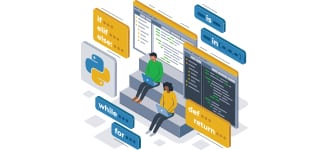Building a data science portfolio is a critical step in showcasing your expertise, creativity, and problem-solving abilities to potential employers or collaborators. Whether you’re an aspiring data scientist or a seasoned professional, a well-crafted portfolio serves as tangible proof of your skills, demonstrating how you approach real-world problems with data-driven solutions. In this guide, we’ll walk you through the essential steps to create a standout data science portfolio that highlights your strengths, features diverse projects, and sets you apart in this competitive field.
What is a Data Science Portfolio?
A data science portfolio collects projects, experiences, and skills you’ve gained through your education and career. It can also be used to showcase your work to potential employers.
A strong portfolio demonstrates your ability to use data science to solve real-world problems. It’s like a resume, but instead of listing your past jobs, it shows off the projects you’ve worked on and how they’ve helped others.
Data science portfolios and resumes for freshers are significant when applying for jobs in an industry like healthcare or finance, where there are strict regulations about what kind of information companies can collect from people. You’ll need to show how to handle sensitive data responsibly before working at any company that takes sensitive information!
Why do you need a portfolio?
If you’re a data scientist, you might wonder why you need a portfolio and how to make a data science resume. After all, it’s not like your resume—it will not get you in the door or help your interviewers understand your skills and talents. But just because it doesn’t have the same function as your resume doesn’t mean it can’t help you get hired.
The truth is, hiring managers don’t care about your resume. They care about what they can see on your website, LinkedIn profile, or your data science resume on GitHub. A well-designed portfolio can show them that:
- You know how to use the tools of the trade (whether that’s R Studio or other software)
- You have industry-relevant skills and experience
- You’re good at communicating with others
Critical components of an ideal data science portfolio
Data science is a field that requires a lot of data and code, so it’s essential to have a data science resume for freshers and a portfolio that is as strong as you are.
Here are the critical components of an ideal data science portfolio:
- A catchy bio
Your bio should be short and sweet. It should let potential employers know who you are, what you’ve done, and what makes you unique. Don’t forget that this is a marketing document—you’ll want to ensure it’s written with clarity and conciseness in mind so that it gets all the relevant information quickly and effectively.
- Quick load time
You don’t want someone clicking on your portfolio only to find that it takes forever for the page to load or, worse yet, crashes altogether! If your web developer tells you they can’t make any improvements because they’re already optimizing everything they can think of, consider adding low-size images or videos.
- Professional look
Your portfolio should have a professional design. It should look clean and simple, easy to navigate, and pleasant. This helps show potential employers that you can create beautiful, functional websites and apps. Using the right colors is a great way to make your portfolio shine. Contrasting colors are bold and eye-catching, while muted tones are more conservative and subtle. Think about what kind of impression you want to make on potential employers (or clients), and then choose colors accordingly.
- Showcase your top-quality projects
An essential part of any good portfolio is showing off your best work—the projects you’re most proud of. Make sure these projects are showcased prominently on your page, so employers know exactly where to start when looking through your work. If you have more than one project in mind for this spot, highlight your best project first—this will help guide visitors through your project list so they can get an idea of how much time and effort went into each one.
- Add testimonials, if any
In your portfolio, you should include testimonials from clients and colleagues who have worked with you. These testimonials can be in the form of an email or a screenshot of an email, or they can be a short video or audio file.
- Precise contact details
Your contact details should be easily visible to anyone who wants to reach out to you and discuss your work. Include both your email address and your company email address—and if you have one, include a LinkedIn profile link so that people can connect with you there.
How to build an impactful Data Science portfolio?
Your Data Science portfolio is a crucial part of your job search and can make or break your chances of landing your first job.
- Add an impressive introduction
The beginning of your portfolio is the first thing people will see, so you must make it as impactful as possible. This means including a brief but exciting introduction that gives a taste of what you’re about to read. The introduction should include your name and contact information if anyone wants to reach out with questions.
- Provide all details in the About section
Include a detailed “About” section to give potential employers or clients more information about yourself and your accomplishments. This section should include your education, work experience, and any particular knowledge or data science skills resume relevant to the job or project. It should also show off any awards or recognition you’ve received for past projects/work, as well as any publications or presentations you’ve given on related topics, so potential employers know they’re hiring someone who’s not just good at data science but also passionate about it!
- Feature a few promising projects
Your portfolio should include a few projects that show off your work, including data science projects.
When starting, it can be tempting to add every project you’ve ever done, but this is only sometimes the best idea. Instead, focus on the most relevant ones to your current job search. If you’re applying for a data scientist role, consider this a data science portfolio example; it’s better to feature projects showing off your data science skills than highlight your coding abilities.
Consider this as one of the data science resume examples; if one of your projects was an analysis of customer behavior on your company’s website or app (which would be helpful for anyone looking for a marketing role), then make sure that the description includes details like how much traffic came from each source and which channels were most effective at driving those visits so that prospective employers can see how well you understand their business model and goals.
Also, remember the following points while creating a project:
- Create a page for each project
You want to ensure that your portfolio is easy to navigate, so we recommend creating a separate page for each project you’ve worked on. This will help potential employers see what you were working on at different points in your career and what kind of work you were doing.
- Add detailed descriptions of each project
Make sure to include all the details about the projects you worked on—who it was for, what was accomplished during its completion, and why it was essential to the company or organization that hired you to do the work in question. Be sure not to leave anything out!
Dos and don’ts to build an exceptional portfolio
The portfolio is the first thing potential employers will see when they Google you, so it’s essential to have one that presents you in the best light possible. It can be hard to know what makes a good portfolio, though—especially when starting out with no work experience.
Here are some dos and don’ts for building an exceptional portfolio:
Dos:
- Spend some money to host your portfolio
Spending thousands of dollars on your site is unnecessary, but you mustn’t use free services like Blogger or Tumblr. Hosting your domain name—even if it’s just one that redirects back to your blog or another hosting service—gives you more flexibility with how you lay out your content and offers visitors a better impression of who you are as a designer and what kind of work you do.
- Purchase style and design
Purchase style and design from other designers instead of creating everything from scratch yourself. There are many great resources online where you can find fonts, templates, layouts, logos, etc., all for very reasonable prices (even free sometimes!). Use these resources instead of trying to recreate the wheel by designing everything yourself; this is time-consuming and often results in subpar results.
To ensure your portfolio conveys the right message, you should invest in simple, clean design elements like fonts and colors that will help tell your story without distracting it.
- Feature your employability skills
In the next section of your portfolio, discuss what makes you a great candidate for a job. This is the time to show off your data science skills and resume, which makes you an exceptional candidate and different from others.
This could include an overview of your education, work experience, or even volunteer work that helped you develop your skills or interests.
- Talk about tools you’re comfortable with
This portfolio section discusses your essential tools and how they will help you succeed in your career. This could include software programs like Photoshop or Illustrator to hardware like a laptop or a tablet. Remember: employers want to know what tools will be most helpful for completing your work!
Don’ts:
- Avoid copying others’ portfolios
Copying other portfolios can be tempting, but there are better ways to build your own. Instead, try to focus on creating an informative and authentic portfolio.
- Avoid using stock photos
- Avoid using fonts that are too fancy or difficult to read
- Use a maximum of two different fonts per document.
- Avoid making your portfolio too long (1-2 pages is best)
- Never use formulaic website templates
There are many reasons not to use formulaic website templates, but the main one is that they’re boring. You need to stand out from the crowd to have an exceptional portfolio. This can only happen if you’re creating unique and interesting content, which you can’t do when you rely on cookie-cutter templates.
This doesn’t mean that your site needs to be unique—it just means that it shouldn’t look like every other site out there. You can still use some of the same elements as other designers but mix them up in ways that make them feel fresh.
- Only include works you are proud of
When building your portfolio, you must include only projects you’re proud of. If a project doesn’t meet your standards for quality, try to find something else in your portfolio that does—even if it’s not exactly what this client asked for.
If you include work that doesn’t meet your standards, explain why it’s not perfect or show how you’ve improved upon the earlier version.
Conclusion
The online Msc in data science by Manipal Academy of Higher Education (MAHE) and online PGCP in data science by Manipal Institute of Technology (MIT) available on the Online Manipal website are ideal for working professionals who want to advance their careers in the field. The course syllabus covers all essential topics, from statistical modeling and machine learning to big data environments, taught by experts in the area. You’ll learn to use Python and R for data analysis and implement big data solutions like Hadoop and Spark. You’ll also be able to choose from various electives, such as artificial intelligence or deep learning.
With such a comprehensive curriculum, you’ll emerge from this program with everything you need to become a sought-after data scientist in today’s competitive job market!
Key takeaways:
- Even if you still need to get out of college, it’s never too early to start building your resume. If you’re considering pursuing a career as a data scientist, getting some relevant experience on paper can help you get noticed by recruiters and make yourself more attractive to potential employers.
- Work on a project that’s relevant to the career field you’re interested in. If you want to work in finance and don’t have any experience with stocks, consider building a portfolio around what it takes to predict the value of a stock.
- Focus on projects that are innovative and unique. If your project doesn’t bring anything new to the table, it won’t impress anyone—including employers.
- Be sure that your portfolio includes data analysis and visualization. Most people struggle in these two areas, so employers will be impressed if you can show off your skills here. At the same time, make sure your visualizations help tell a story about what’s going on in your data set rather than just being pretty pictures.
Become future-ready with our online M.Sc. in Data Science program












